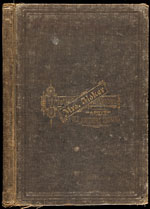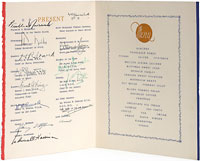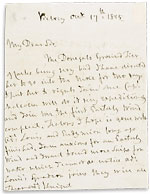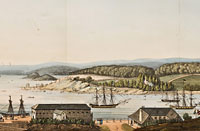The Wright Stuff
Abby’s Southern Cookin’
Abby C. Fisher, What Mrs. Fisher Knows About Old Southern Cooking, Soups, Pickles, Preserves, etc., $6,000 at PBA Galleries on September 2.
Printed in San Francisco in 1881 at the Women’s Co-operative Printing Office, this little work of just seventy-two pages was only the second cookbook* written by an African American. Born in 1832 in South Carolina to a black mother and a French father, Abby Fisher is designated a mulatto cook in 1880 census records for San Francisco, where she and her husband ran a pickle factory. This rare first shows some wear and soiling to the gilt lettered cloth, and has previous owners’ names in ink on front endpapers along with other ink and pencil markings—even a few pencilled math equations on rear endpapers!
The selling price was a little down on what PBA had hoped, but six years ago they got $13,225 for a copy inscribed by Mr. & Mrs. A. C. Fisher to someone who may have been over-indulging in Abby’s southern fare—a Mr. Stout.
*Abby Fisher’s book is preceded only by the exceptionally rare Mrs. Malinda Russell’s A Domestic Cook Book, published for the author in Paw Paw, Michigan, in 1866. No copy appears in auction records.
Signatories to History in the Making
Menu signed by Roosevelt and Churchill, $21,960 at Bonhams New York on June 23, and a letter written by Admiral Nelson before the Battle of Trafalgar, £32,450 ($49,570) at Sotheby’s in London on July 15.
The menu is a souvenir of a dinner given in Churchill’s honor by the US president on the first day of the Atlantic Conference. Held aboard warships in Ship Harbour, Newfoundland, this was the secret meeting of August 1941 in which a mutual vision for a post-war world was discussed, along with more pressing strategic plans in a conflict that, with Pearl Harbour still a few months off, the United States had yet to officially enter, and which still had a very long way to go.
Those present have added signatures alongside the printed details of their names and political or military status, and this fully signed copy of the menu came to auction from the estate of one of that distinguished number, General Henry Harley ‘Hap’ Arnold.
The menu itself might not appeal to everyone’s taste today, though for the British team, already used to wartime ration restrictions, it was probably welcome. The main course was broiled spring chicken with buttered sweet peas, candied sweet potatoes and mushroom gravy, but there was sliced tomato salad, assorted cheese, chocolate ice cream, cookies, and cupcakes to come – and, of course, cigars.
Apparently unpublished and unrecorded, the Nelson letter is one in which he writes of final preparations for his greatest but final naval victory, the Battle of Trafalgar. Dated October 17, 1805, it was addressed to Rear Admiral Knight, commanding the port at Gibraltar—where Nelson’s ships were being sent for supplies and spares, and where, just ten days after the letter was written, Nelson’s lifeless body would be returned.
After referring to repairs on the sails of the Donegal and giving instructions for supplies, Nelson tells Knight that he is “anxious for an Easterly Wind” that would both ease his communications with Gibraltar and encourage the Franco-Spanish fleet to leave harbor. The very next day his wish was granted, and Villeneuve gave orders for his combined fleet to prepare for sea.
One other line in the letter has a very modern ring to it. “We shall soon be in distress for water,” Nelson tells Knight, “but keep this to yourself or we shall see it in an English newspaper.”
Sheep Grazing for the New Colonists
James Atkinson, An Account of the State of Agriculture and Grazing in New South Wales … with other information important to those about to emigrate to that country, Aus$34,950 ($29,575) at Peter Arnold/Michael Treloar in Melbourne on August 2.
The years following the Napoleonic wars were difficult economic times for many in Britain, and Atkinson was one of those who decided to try his luck elsewhere. Having lost his job as a naval clerk, he put his family farming background to some use and managed to raise enough capital to obtain a land grant in the still young Australian colony of New South Wales. In 1821 he settled at Bong Bong in the region’s Southern Highlands, but three years later, whilst on a return visit to England, found himself assailed with questions about the state of agriculture and grazing in the colony.
Drawing on his experiences, he produced this work, which offered prospective settlers both a survey of the agricultural districts and larger pastoral properties, and a practical guide to rural and domestic economy. Published in London in 1826, this octavo volume was issued in two forms, priced at seven and fourteen shillings—the more expensive, and today, most desirable version containing additional illustration.
This copy of the first book on Australian agriculture, in rebacked contemporary calf, was part of the collection of Harry Muir (1909-92), an Adelaide bookseller, publisher, and collector.
Atkinson published two further works on sheep farming and brewing. Some years after her husband’s death, his widow Charlotte Barton (by then unhappily remarried, but that is another story) published in 1841 the first recorded Australian book for children, A Mother’s Offering to her Children.








 Ian McKay’s weekly column in Antiques Trade Gazette has been running for more than 30 years.
Ian McKay’s weekly column in Antiques Trade Gazette has been running for more than 30 years.


